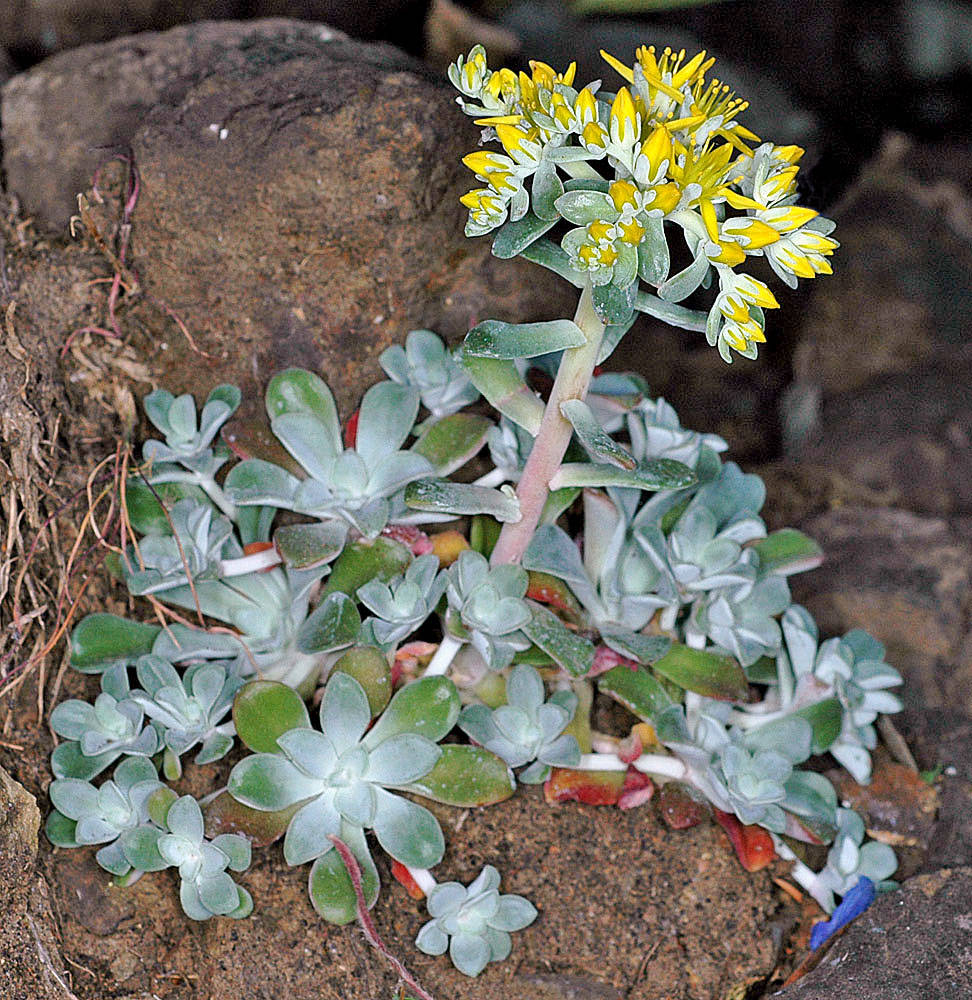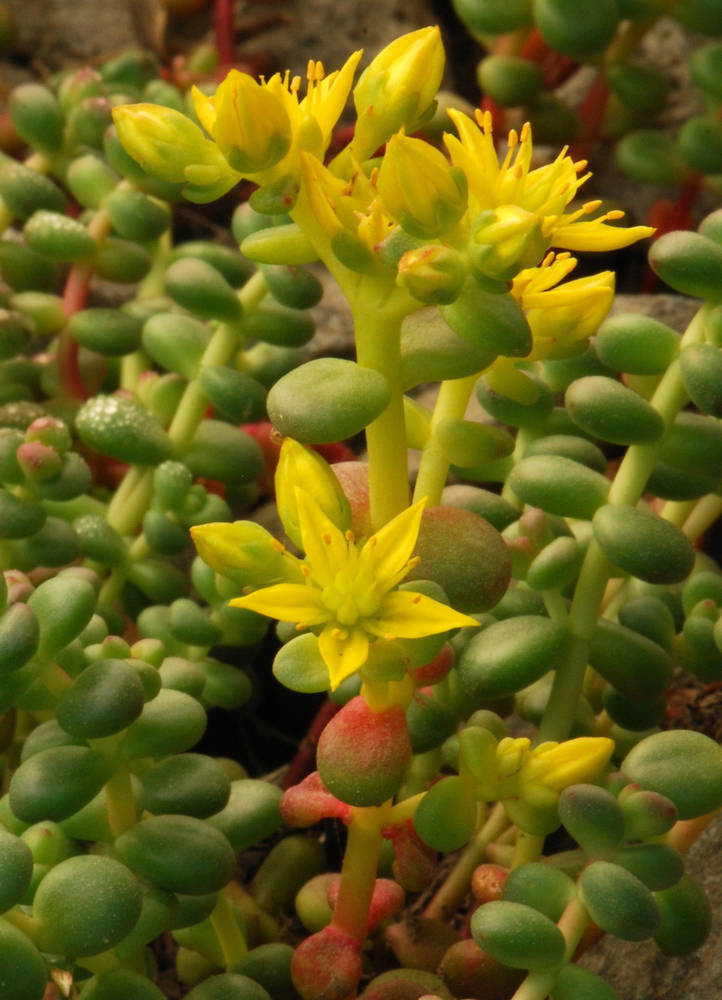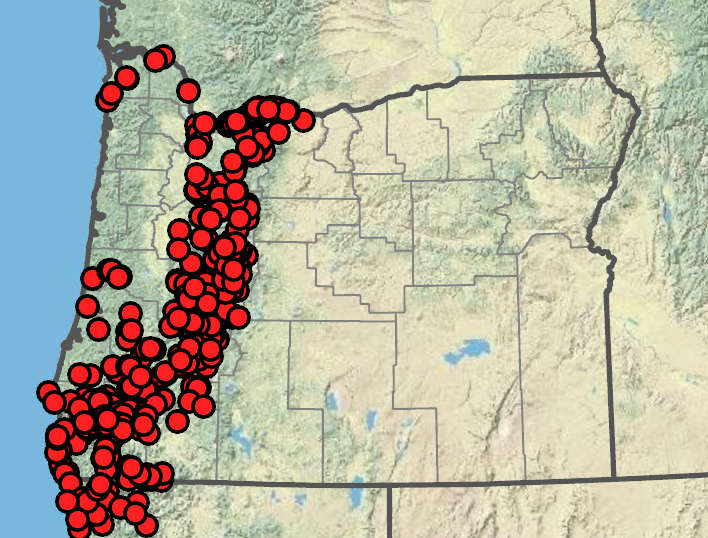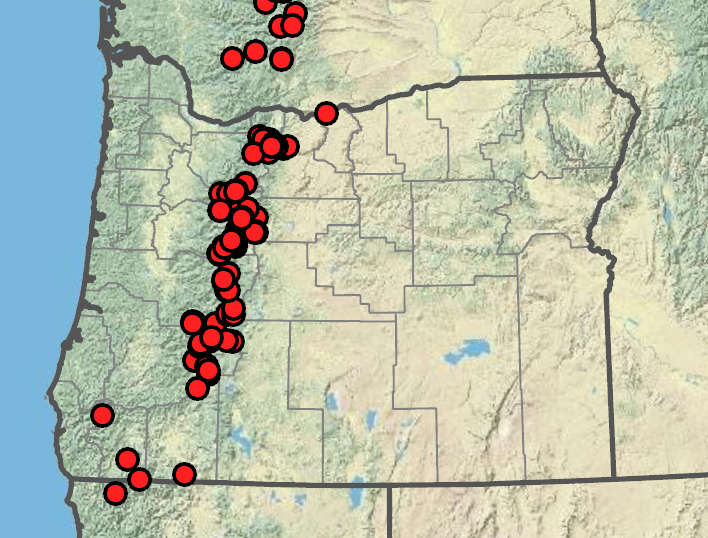Sedum spathulifolium
Sedum divergens
broadleaf stonecrop
Cascade stonecrop, Pacific stonecrop, spreading stonecrop
extensively stoloniferous, with dense terminal rosettes.
decumbent, becoming erect or ascending, branched; without rosettes.
erect; simple, 3–14 cm;
stem leaves alternate, spatulate-oblong or elliptic-oblong; widest at or below middle, different from rosette leaves.
erect, rarely branched, 6–10 cm;
stem leaves suborbicular to obovate or oblong, dried stems 1.5–2 mm thick.
rosette leaves spreading, usually nearly parallel to ground, usually forming flat rosettes, spatulate, narrowing to petioles, 7–19 × 4.5–10 mm, 5 × as wide as thick, green or pruinose and white, bases not spurred, not scarious, sometimes muricate or papillose near margins;
tips rounded or truncate;
surfaces usually glaucous.
opposite, rarely alternate, 2-ranked, suborbicular to obovate or oblong, subterete; ± globular, 4–9 × 4–6 mm, green or red, bases slightly clasping;
tips rounded;
surfaces not glaucous; shiny.
cymes with ~30 flowers, 3-branched;
branches forked;
bracts oblong-spatulate or linear.
cymes with 5–25 flowers, 2–3-branched;
branches recurved to erect;
bracts similar to other leaves or elliptic to broadly lanceolate, 2–5 mm.
5-parted;
sepals spreading to erect, lanceolate, linear-lanceolate, oblong-ovate or obovate; ~2.5 × 1.5 mm, green to yellow-green;
tips acute or obtuse;
surface glaucous or pruinose;
petals strongly spreading above erect base, linear to oblanceolate, 4.5–9 mm, yellow;
tips acute;
filaments yellow;
anthers yellow.
5(7)-parted;
sepals ovate, 2–3 × 1.5–2 mm, green;
tips obtuse;
petals erect basally, widely spreading from about middle, usually distinct; narrow; ~5 mm, yellow;
tips acute or obtuse and with an apiculus;
filaments yellow;
anthers yellow.
erect until mature then spreading, fused basally, brown.
widely spreading, fused at base, red or reddish brown to straw-colored.
=16.
Sedum spathulifolium
Sedum divergens
Rocks, cliffs and road cuts. Flowering Apr–Aug. 0–2400 m. Casc, Col, CR, ECas, Est, Sisk, WV. CA, WA; north to British Columbia. Native.
Sedum spathulifolium is highly variable. If subspecies are recognized, most of our plants are S. spathulifolium ssp. spathulifolium. A coastal form with thick, white-pruinose leaves, short, stout stolons, dense inflorescences and thick, crowded stem leaves can be called S. s. ssp. pruinosum (if it is considered a strictly coastal entity). If it is considered to include strongly glaucous or pruinose plants of the Coast Range that are less dense in growth form, the name S. s. var. minus would be applied. Plants with thin, green leaves, numerous long, slender stolons that tend to grow upwards before growing out, paler flowers, and more spreading follicles can be called S. s. ssp. purdyi, a rare form known only from southern Josephine County, and Del Norte and Siskiyou counties in California.
Rocky slopes, talus, lava. Flowering Jun–Aug. 1200–2300 m. Casc, Sisk. CA, WA; north to AK, northeast to Alberta. Native.
Within this species, each pair of leaves is at a right angle to the pair below it, forming two columns of almost round, green to red leaves. This leaf arrangement is unique among our native Sedum. Sedum debile has opposite leaves, but they are glaucous and often whitish, and they form ball-like rosettes. The two species do not overlap in range. Sedum divergens may recall particularly thick-leaved individuals of S. oreganum, but the latter species does not have such neat columns of leaves, and its petals are much longer and nearly erect.
Barbara Wilson, Richard Brainerd, Nick Otting
Barbara Wilson, Richard Brainerd, Nick Otting
- Local floras:
BC,
CA,
OR,
WA
- Local Web sites:
CalFlora,
CalPhotos,
Flora NW,
PNW Herbaria,
Turner Photog.
WildflowerSearch
iNaturalist (observations)
USDA Plants Database
- LBJ Wildflower Center
- SEINet
- Plants of the World Online
- Encyclopedia of Life
- Wikipedia
- Google Image Search
- Local floras:
BC,
CA,
OR,
WA
- Local Web sites:
CalFlora,
CalPhotos,
Flora NW,
PNW Herbaria,
Turner Photog.
WildflowerSearch
iNaturalist (observations)
USDA Plants Database
- LBJ Wildflower Center
- SEINet
- Plants of the World Online
- Encyclopedia of Life
- Wikipedia
- Google Image Search





